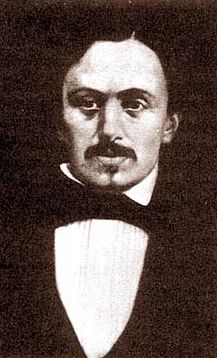Francisco Gonzalez Bocanegra (Francisco Gonzalez Bocanegra)

Poet. He was born in San Luis Potosí, Mexico. In 1827, the González family moved to the port of Cádiz, Spain. In 1836, they returned to San Luis Potosí, Mexico where Francisco spent time working at his father’s commerce business. In 1846 he moved to Mexico City, began publishing his first poems and became a member of the Letrán Academy. Bocanegra also worked as a theater censor and was appointed director of the official newspaper. In 1850 he founded and served as president of Hidalgo Grammar school. In 1853, Mexico’s President Antonio López de Santa Anna held a contest to compose the Mexican National anthem. As the submission deadline approached, Bocanegra found he was unmotivated to participate. While at the home of his cousin/fiancée, Guadalupe González de Pino y Villalpando, Bocanegra found himself locked in a room with nothing but a desk, paper and pen. His fiancée sternly informed him that she would not open the door until the poem was completed. Bocanegra, suddenly inspired, completed the poem “Mexicanos, al Grito de Guerra” (“Mexicans, at the Cry of Battle”) approximately 4 hours later and slid it below the door. His submission went on to be unanimously selected by contest judges and Jaime Nunó’s musical composition titled, “God and Liberty” was chosen to accompany Bocanegra’s lyrics. The completed song was called “Himno Nacional Mexicano” and was first played September 15, 1854 (Mexican Independence Day) in the Teatro Santa Anna which became known as Teatro Nacional. The original poem consisted of 10 verses but after the country’s defeat in the Mexican-American War, stanza IV was forbidden because it referenced Antonio López de Santa Anna, blamed for the defeat, and stanza VII referred to the first Mexican Emperor Agustin de Iturbide, who was exiled and executed. Today only the chorus is sung in the beginning, between stanzas I, V, VI and X and at the end. Bocanegra married Guadalupe and had four daughters: Elisa, Guadalupe, Angela and María de la Luz. A public employee until persecuted by enemies of the administration he served in 1861, he had to take refuge in the house of a friend. He died there and his remains were originally interred in San Fernando’s Vault. In 1901 they were transferred to Dolores’s Vault; in September of 1932, they were placed for the first time in the Rotonda de los Hombres Ilustres (Rotunda of Illustrious Men) and, finally, in 1942 they were placed beside those of composer Jaime Nunó. (bio by: So Cal Graver)Cause of death: Typhus. (bio by: SCG)
Born
- January, 08, 1824
Died
- April, 04, 1861
Cause of Death
- Typhus. (bio by: SCG)
Cemetery
- Panteón Civil de Dolores
- Mexico

